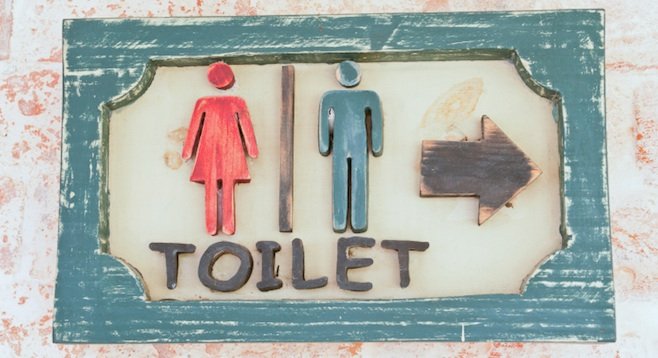 Facebook
Facebook
 X
X
 Instagram
Instagram
 TikTok
TikTok
 Youtube
Youtube

Heymatt:
Why do gender-specific, single-occupancy restrooms exist? I see things like, for example, a queue of women outside the women’s room when there is plenty of space in the adjacent men’s room, or vice-versa. Why not just have two, non-specific restrooms that anybody could use? Many establishments have restrooms designated for both genders. Why isn’t this universal?
— Michael, Scotts Valley
Let’s say you’re at a bar with a bunch of other dudes, watching the football game with precious few ladies in sight — a regular sausage party, if you will. Half-time rolls around and every bro in the place lines up at the boys’ room, holding his bladder and casting envious glances toward the unoccupied ladies’ room just down the hall. Well, you can thank the state plumbing code, specifically section 412.3, which states, “separate toilet facilities shall be provided for each sex.”
Of course, real-world compliance with that code is going to be spotty at best. The most recent edition of the California plumbing code is from 2010 and most buildings predate that. It’s not like the “separate restrooms” provision is new or anything, but lots of bathrooms out there are technically out of code for one reason or another, such as those multi-use bathrooms you mention. Over the years, codes have expanded to include more different restrooms rather than less, so your dreams of non-specific bathrooms for all are unlikely to come true. I would predict that future iterations of the code will call for at least three bathrooms in every restaurant: one male, one female, and one exclusively for disabled customers.


Heymatt:
Why do gender-specific, single-occupancy restrooms exist? I see things like, for example, a queue of women outside the women’s room when there is plenty of space in the adjacent men’s room, or vice-versa. Why not just have two, non-specific restrooms that anybody could use? Many establishments have restrooms designated for both genders. Why isn’t this universal?
— Michael, Scotts Valley
Let’s say you’re at a bar with a bunch of other dudes, watching the football game with precious few ladies in sight — a regular sausage party, if you will. Half-time rolls around and every bro in the place lines up at the boys’ room, holding his bladder and casting envious glances toward the unoccupied ladies’ room just down the hall. Well, you can thank the state plumbing code, specifically section 412.3, which states, “separate toilet facilities shall be provided for each sex.”
Of course, real-world compliance with that code is going to be spotty at best. The most recent edition of the California plumbing code is from 2010 and most buildings predate that. It’s not like the “separate restrooms” provision is new or anything, but lots of bathrooms out there are technically out of code for one reason or another, such as those multi-use bathrooms you mention. Over the years, codes have expanded to include more different restrooms rather than less, so your dreams of non-specific bathrooms for all are unlikely to come true. I would predict that future iterations of the code will call for at least three bathrooms in every restaurant: one male, one female, and one exclusively for disabled customers.
Comments